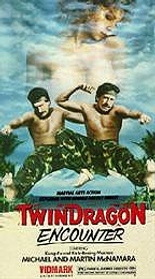
 Oh, man, where to begin? Martin and Michael McNamara are twins and founders of the real-life Twin Dragons Kung Fu Club. Despite looking like a godforsaken mix of Yanni, Chuck Norris, Robert Reed, Kenny Loggins, Geraldo Rivera and that guy who played Matt Houston, they decided they needed to be in the movies. But because there’s no market for goofy-looking Canadian boneheads who do karate, they had to make their own. One of them is Twin Dragon Encounter — a too-close Encounter of the unkind.
Oh, man, where to begin? Martin and Michael McNamara are twins and founders of the real-life Twin Dragons Kung Fu Club. Despite looking like a godforsaken mix of Yanni, Chuck Norris, Robert Reed, Kenny Loggins, Geraldo Rivera and that guy who played Matt Houston, they decided they needed to be in the movies. But because there’s no market for goofy-looking Canadian boneheads who do karate, they had to make their own. One of them is Twin Dragon Encounter — a too-close Encounter of the unkind.
The brothers basically play themselves (which makes me feel sorry for anyone who has to live and/or interact with them) and they’re quite full of themselves, as an opening credit crawl informs us that they are “the country’s most renowned martial artists,” yet every Canadian I’ve asked has never heard of them. Cue the pure-‘80s hair-rock theme song (“Fight for Your Right to Fight,” by one Billy Butt) and montage of shirtless men exercising and hitting each other playfully like kittens.
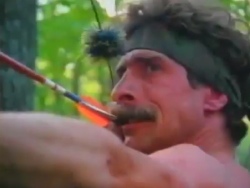 After this brutal, near-endless workout, the brothers pack their identical vans to go “on holiday” with their nondescript rail-thin girlfriends, whom they delight in kicking around and putting down at every opportunity. Following several insufferable driving sequences, they finally arrive at “Twin Island,” the boys’ own slice o’ paradise on the lake. At the dock, however, they’re immediately menaced by a gang of “weekend warriors,” whom they take down in a ridiculous slow-motion fight.
After this brutal, near-endless workout, the brothers pack their identical vans to go “on holiday” with their nondescript rail-thin girlfriends, whom they delight in kicking around and putting down at every opportunity. Following several insufferable driving sequences, they finally arrive at “Twin Island,” the boys’ own slice o’ paradise on the lake. At the dock, however, they’re immediately menaced by a gang of “weekend warriors,” whom they take down in a ridiculous slow-motion fight.
These bad guys — led by a cigar-chomping near-albino with huge facial pores and a Mohawk — vow revenge and spend the weekend plotting to harass the McNamaras, who are too busy sawing and chopping firewood in the middle of summer and ignoring their beards to notice. But when the bad guys bust in their cabin and take the girls, the twins plot revenge. One has to question their motives, as when they enter their dishelveled cabin, the first thing they say is a panicked “Our poster’s gone!” Girls schmirls!
These McNamara boys fail cinematically, so I wouldn’t hesitate for a second to watch anything they produce. —Rod Lott

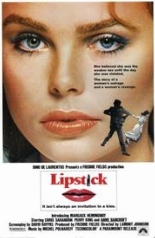
 How can you tell
How can you tell 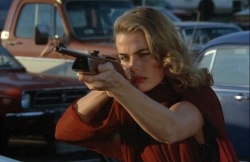 Tragically, however, Sarandon is in the same building as the shoot and decides to attack Margaux’s adolescent sister (her real-life sibling, Mariel). Knowing the law isn’t on her side, Margaux decides to grab a shotgun and ensure Sarandon never hurts anyone else ever again (by shooting him in the balls).
Tragically, however, Sarandon is in the same building as the shoot and decides to attack Margaux’s adolescent sister (her real-life sibling, Mariel). Knowing the law isn’t on her side, Margaux decides to grab a shotgun and ensure Sarandon never hurts anyone else ever again (by shooting him in the balls).

 Enter
Enter 
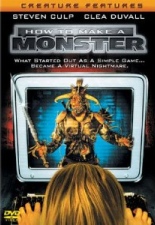
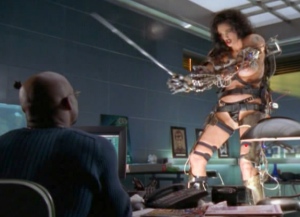 Deliberately cartoony, the movie makes no attempt at all to depict the authentic realities of game production, which wouldn’t be a problem if Huang hadn’t decided to rip himself off and use the film to re-tell the same story he told in his first and much, much, much better picture. By the time Monster ends with a newly jaded Clea DuVall (in the Frank Whaley role) schooling a new intern in the cold, cruel realities of the world, it becomes agonizingly clear that by his third film, Huang had already shot his entire creative wad, leaving him with nothing else to say.
Deliberately cartoony, the movie makes no attempt at all to depict the authentic realities of game production, which wouldn’t be a problem if Huang hadn’t decided to rip himself off and use the film to re-tell the same story he told in his first and much, much, much better picture. By the time Monster ends with a newly jaded Clea DuVall (in the Frank Whaley role) schooling a new intern in the cold, cruel realities of the world, it becomes agonizingly clear that by his third film, Huang had already shot his entire creative wad, leaving him with nothing else to say. 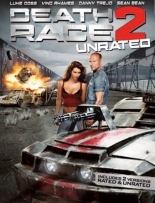
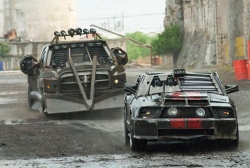 She proposes “a race: wicked, epic,” which begets the Death Race we all know and love. One of its instant superstars is Terminal Island’s newest residents, Carl Lucas (Luke Goss of
She proposes “a race: wicked, epic,” which begets the Death Race we all know and love. One of its instant superstars is Terminal Island’s newest residents, Carl Lucas (Luke Goss of